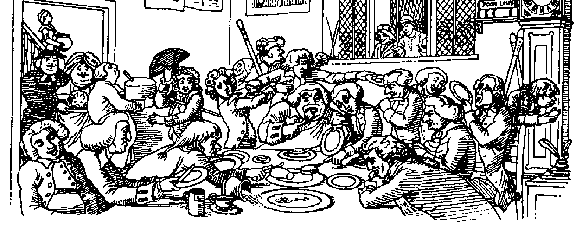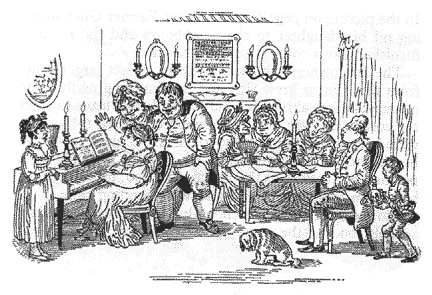End of Year Feasting
By: Timothy W. Shire

The North American custom of feasting at Christmas and New Years, and perhaps throughout the so-called “holiday season” is interesting in its origin. Canada, United States of America and Mexico were all settle from the time of Elizabeth until the end of the eighteenth century, Though migration continued well after that, the traditions of this time period were well established in North American and it doesn’t matter if the people coming to the New World were from Spain, France, Germany or England, these are all Northern European peoples and they brought with them their customs and traditions that formed the basis of what is today North American culture. As we well know, this culture varies considerably North and South on the continent as does the ethnical background of the people who settled here.
There are two interesting exceptions to this cultural mix, the people who were already here, the North American Aboriginal people, and the Afro-Americans brought to North America as slaves. The North American aboriginal peoples were themselves North Temperate zone dwellers, or the latitude in which they live, was similar to the latitude of the new comers. The Afro-Americans on the other hand were slaves who had their culture ruthlessly expunged from them and they adopted their version of what they considered the basic elements of their master's culture.
To get a grasp on this concept we all are aware that with the exception of the Mexican Aborigines, most of the world’s population, with a few exceptions, did not have a good working calendar until the eighteenth century. The Greeks and Roman people handled the problem of the days of the year being a bit difficult to balance against the movements of the moon and solved the problem by simply making the months of the year equal and partying for the last two weeks of the year. Their custom was to party, though no doubt some of that was feasting, it did not take on the indulgence of the Northern Europeans.
Food preservation is a relatively modern technological innovation and the people of the time when North American was being settled generally cleaned up on their livestock at the end of the year and thus there existed what was necessary for feasting. The cultures accepted this seasonal bounty as the norm and included it in their customs. It is very important to understand just how serious this over eating was. The problem affected the health of people to the extent that Northern Europeans, especially the British, but it was also the case in Germany and France, suffered from diseases related to overeating high protein foods. By the eighteenth century, even though health conditions were steadily improving, life expectancy among males was remarkable low by our standards and among the custom setting middle and upper classes, gout was the major difficulty experienced by these men. Women on the other hand continued to be somewhat endangered as reproductive technology was sadly lacking, as were other health related problems, some even relating to fashion, causing their life expectancy to be equally lowered.

A robust health English gentleman was expected to wear his wealth and importance around his waist often had feet so swollen that he was unable to walk, this was the norm rather then the exception. The term “great” was used to describe a man and did not apply to his deeds but more likely to his weight. Woman considered such men as attractive because they proved by their corpulence their ability to provide for her and her children, thus being a good prospective mate.
As the agricultural revolution proceeded the English discovered that turnips could be used as cattle feed and thus reduced the need to slaughter most of their none breeding stock as the end of the growing season, but nevertheless, the custom of massively overeating was well ingrained in the culture. Not only is the custom described in detail by fiction authors of the day, but was well spelled out by people like Dr. Johnson who carefully recorded the way of life so that we can easily research the life style of this formidable period in the development on this side of the Atlantic.
It is interesting to note that the in Canada and Northern portion of the United States, the custom of feasting at the end of the year was also firmly established well before the arrival of the European invasion. There were some similar reasons even though these people were hunters and gatherers, rather then completely agricultural like their European counterparts. Bison and Caribou hunts were largely a fall and early winter activity and thus providing for plenty at the time of year’s end. Similarly, it was at this time of the year that the fall migration of birds took place and on the coasts the end of the fishing season.
The ugly weather associated with winter comes to the Pacific coast in November and does not leave until March so for four months of the year these people devoted themselves to feasting and a succession of ceramonial events. You might not realise that the culture of the West Coast Aboriginal people is very likely among the oldest continuous cultures on this planet and certainly one of the most advanced. Europeans when first seeing these people mistook the way of life and elements from their own culture that were missing and therefore assumed these people were primitive or at least less developed then themselves. They were wrong.
 The winter
season for the West Coast people was one of high culture and almost non-stop celebration
with feast following feast (Potlatch). This culture is extremely complex with the
most extensive developments in drama, dance and art forms unsurpassed anywhere. The
Europeans assumed that since they did not have a written form of language then they
were less developed, whereas the West Coast people transcended the use of the spoken
word, using it for decoration in highly developed rhetoric, but the main elements
of their culture, the important stuff, was embedded in their dance and art forms.
Only now are we as a culture beginning to realise that so much more can be told and
understood through graphics then through words. The extensive variations of languages
in all of North America made the development of written material difficult so to
communicate, Amerind (American Indian Sign Language) developed which is not based
on words but instead is based on concepts, thus making it a highly sophisticated
form of communications, was universally used and remarkably subtly passed on to us,
so that if you encountered someone using Amerind you would easily understand between
80% to 90% of the signing because we use these gestures without realising their origin.
The winter
season for the West Coast people was one of high culture and almost non-stop celebration
with feast following feast (Potlatch). This culture is extremely complex with the
most extensive developments in drama, dance and art forms unsurpassed anywhere. The
Europeans assumed that since they did not have a written form of language then they
were less developed, whereas the West Coast people transcended the use of the spoken
word, using it for decoration in highly developed rhetoric, but the main elements
of their culture, the important stuff, was embedded in their dance and art forms.
Only now are we as a culture beginning to realise that so much more can be told and
understood through graphics then through words. The extensive variations of languages
in all of North America made the development of written material difficult so to
communicate, Amerind (American Indian Sign Language) developed which is not based
on words but instead is based on concepts, thus making it a highly sophisticated
form of communications, was universally used and remarkably subtly passed on to us,
so that if you encountered someone using Amerind you would easily understand between
80% to 90% of the signing because we use these gestures without realising their origin.Feasting at the end of the year is a fact of North American culture established here by the people when they came to this land and practised by the original inhabitants before they came. Sharing an abundant meal is considered appropriate despite the unsoundness of the practice in terms of our health, but making perfect sense when related to the origins of the custom.